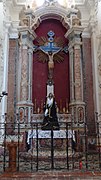
Monreale Cathedral is a Catholic church in Monreale, Metropolitan City of Palermo, Sicily, southern Italy. One of the greatest existent examples of Norman architecture, it was begun in 1174 by William II of Sicily. In 1182 the church, dedicated to the Nativity of the Virgin Mary, was, by a bull of Pope Lucius III, elevated to the rank of a metropolitan cathedral as the seat of the diocese of Monreale, which was elevated to the Archdiocese of Monreale in 1183. Since 2015 it has been part of the Arab-Norman Palermo and the Cathedral Churches of Cefalù and Monreale UNESCO World Heritage Site.

Nicosia is a comune (municipality) in the province of Enna, in the Italian region of Sicily. It is located at 720 metres above the sea level, on a rocky massive culminating in four imposing hills. The origin of Nicosia is uncertain. Nicosia and Troina are the northernmost towns in the province of Enna. The vicinity was traditionally made up of salt mines and arable lands.
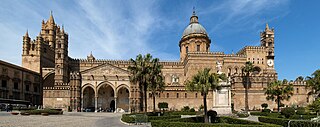
Palermo Cathedral is the cathedral church of the Roman Catholic Archdiocese of Palermo, located in Palermo, Sicily, southern Italy. It is dedicated to the Assumption of the Virgin Mary. As an architectural complex, it is characterized by the presence of different styles, due to a long history of additions, alterations and restorations, the last of which occurred in the 18th century.

Guglielmo Borremans or Guglielmo Fiamingo (1670–1744) was a Flemish painter whose documented career took principally place in Italy, in particular Naples, Cosenza and Sicily. Here he was one of the pre-eminent late-Baroque fresco painters of the first half of the 17th century who received multiple commissions to decorate churches and palaces.
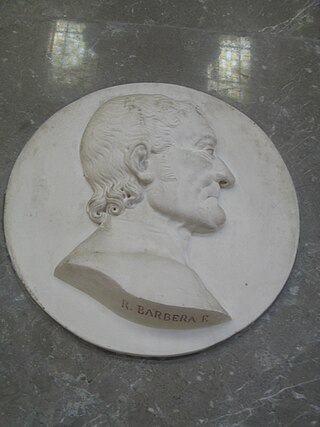
Giuseppe Velasquez, Velasques or Velasco was an Italian painter, active in a Neoclassic style.
Giovanni Forti Natoli or Gianforte Natoli was a Sicilian nobleman, the son of Blasco Natoli Lanza and Domenica Giambruno Perna. He was baron of S. Bartolomeo and Belice. On 20 August 1597 he bought the barony of Sperlinga from Giovanni Ventimiglia, marquis of Gerace, for 30,834 ounces of gold. Natoli was granted a licentia populandi cum privilegium aedificandi by the king of Sicily, Philip II of Spain. In 1627 he was made prince of Sperlinga by Philip IV of Spain.
The Gagini or Gaggini were a family of architects and sculptors, originally from Bissone on Lake Lugano. This family founded Sicily's Gagini school, which flourished until the mid-1600s.

Nicosia Cathedral is the cathedral of the Roman Catholic Diocese of Nicosia, Sicily, and is located in Nicosia, Sicily, Italy. It is dedicated to Saint Nicholas of Bari. The Cathedral preserves a precious and unique wooden roof of 1300.

The Church of Saint Francis Xavier is a Baroque church of Palermo. It is located on the Street of the same name in the quarter of the Albergaria, within the historic centre of Palermo. The building is considered the masterpiece of the Jesuit architect Angelo Italia.
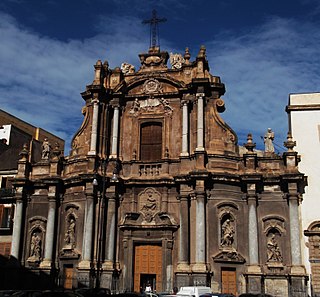
The Church of Saint Anne the Mercy is a Baroque church of Palermo. It is located in the area of the ancient market of Lattarini, in the quarter of the Kalsa, within the historic centre of Palermo. The church is kept by the Third Order Regular of St. Francis of Penance.

The Church of Saint Ignatius is a Baroque church of Palermo. It is located in the ancient neighborhood of the Olivella, in the quarter of the Loggia, within the historic centre of Palermo.
The Diocesan Museum of Palermo is a museum of religious art in Palermo on Sicily, housed in a number of rooms in the Palazzo Arcivescovile opposite Palermo Cathedral.
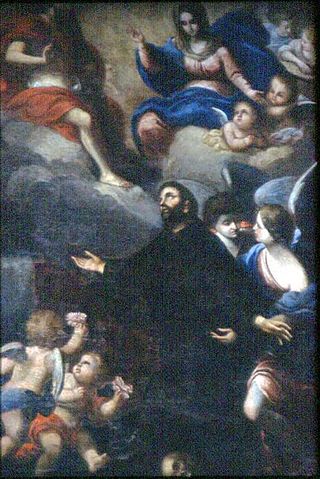
Andrea Carrera or Carreca was an Italian Baroque painter mainly active in Sicily. He was born in Trapani and died in Palermo.
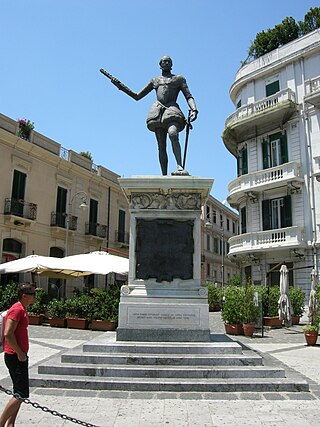
Andrea Calamech was an Italian sculptor and architect.

Rinaldo Bonanno (1545-1600) was an Italian sculptor. Born in Raccuja, he is notable for his work in Sicily in the second half of the 16th century. His whole oeuvre was heavily influenced by the Tuscan tradition and the style of Michelangelo, but combined these with elements of the late Gothic style and influences from the work of Gagini. Despite his 'archaizing' traits, he is considered one of the best sculptors active in that era in Sicily.
Gioacchino Di Marzo was an Italian art historian, librarian and Jesuit. He was librarian to the Comunale di Palermo as well as a historiographer and one of the founders of modern Sicilian art history.
Vito Maria Amico was an Italian monk, historian and writer. He is most notable for the last work published in his lifetime, Lexicon topographicum Siculum..., a topographical dictionary of Sicily published between 1757 and 1760, describing its history, settlements and best-known families, monuments and churches.

Paolo Amato was an Italian Baroque and Rococo architect. He is also notable as author of the treatise La Nuova Pratica di Prospettiva, published in Palermo in 1732.

The Sicilian Renaissance forms part of the wider currents of scholarly and artistic development known as the Italian Renaissance. Spreading from the movement's main centres in Florence, Rome and Naples, when Renaissance Classicism reached Sicily it fused with influences from local late medieval and International Gothic art and Flemish painting to form a distinctive hybrid. The 1460s is usually identified as the start of the development of this distinctive Renaissance on the island, marked by the presence of Antonello da Messina, Francesco Laurana and Domenico Gagini, all three of whom influenced each other, sometimes basing their studios in the same city at the same time.

Johannes De Matta, also known as Juan de Matta was a Spanish painter.







